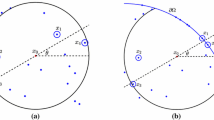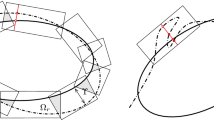Abstract
When solving numerically an elliptic problem, it is important in most applications that the scheme used preserves the positivity of the solution. When using finite volume schemes on deformed meshes, the question has been solved rather recently. Such schemes are usually (at most) second-order convergent, and non-linear. On the other hand, many high-order schemes have been proposed that do not ensure positivity of the solution. In this paper, we propose a very high-order monotonic (that is, positivity preserving) numerical method for elliptic problems in 1D. We prove that this method converges to an arbitrary order (under reasonable assumptions on the mesh) and is indeed monotonic. We also show how to handle discontinuous sources or diffusion coefficients, while keeping the order of convergence. We assess the new scheme, on several test problems, with arbitrary (regular, distorted, and random) meshes.











Similar content being viewed by others
Notes
In the numerical tests, we choose \(\varepsilon = 10^{-12}\).
In the benchmarks, we have chosen \(\epsilon =10^{-11}\).
References
Beirão da Veiga L, Brezzi F, Marini L, Russo A (2016) Virtual element method for general second-order elliptic problems on polygonal meshes. Math Models Methods Appl Sci 26(04):729–750
Bertolazzi E, Manzini G (2005) A second-order maximum principle preserving finite volume method for steady convection–diffusion problems. SIAM J Numer Anal 43(5):2172–2199 ((electronic))
Blanc X, Labourasse E (2016) A positive scheme for diffusion problems on deformed meshes. ZAMM J Appl Math Mech (Zeitschrift für Angewandte Mathematik und Mechanik) 96(6):660–680
Camier J-S, Hermeline F (2016) A monotone nonlinear finite volume method for approximating diffusion operators on general meshes. Int J Numer Methods Eng 107:496–519
Cancès C, Guichard C (2017) Numerical analysis of a robust free energy diminishing finite volume scheme for parabolic equations with gradient structure. Found Comput Math 17:1525–1584
Ciarlet P (1970) Discrete maximum principle for finite-difference operators. Aequ Math 4:338–352
Ciarlet P (2002) The finite element method for elliptic problems, vol 40. SIAM, Philadelphia
Ciarlet P, Raviart P-A (1973) Numerical analysis of a robust free energy diminishing finite volume scheme for parabolic equations with gradient structure. Found Comput Math 2:17–31
Coudière Y, Vila J-P, Villedieu P (1999) Convergence rate of a finite volume scheme for a two dimensional convection–diffusion problem. Math Model Numer Anal 33(3):493–516
Després B (2014) Non linear schemes for the heat equation in 1d. ESAIM M2AN 48(1):107–134
Di Pietro DA, Droniou J (2020) The hybrid high-order method for polytopal meshes, vol 19. Springer, Berlin
Di Pietro DA, Ern A (2012) Mathematical aspects of discontinuous Galerkin methods, vol 69. Springer, Berlin
Droniou J, Le Potier C (2011) Construction and convergence study of schemes preserving the elliptic local maximum principle. SIAM J Numer Anal 49(2):459–490
Evans LC (1978) Application of nonlinear semigroup theory to certain partial differential equations. Nonlinear Evol Equ 163–188. https://doi.org/10.1016/B978-0-12-195250-1.50014-X
Eymard R, Gallouët T, Herbin R (2000) Finite volume methods. In: Ciarlet PG, Lions J-L (eds) Handbook of numerical analysis, vol VII. North-Holland, Amsterdam
Eymard R, Gallouët T, Guichard C, Herbin R, Masson R (2014) TP or not TP, that is the question. Comput Geosci 18(3–4):285–296
Gao Y, Yuan G, Wang S, Hang X (2020) A finite volume element scheme with a monotonicity correction for anisotropic diffusion problems on general quadrilateral meshes. J Comput Phys 407:109143
Hermeline F (2000) A finite volume method for the approximation of diffusion operators on distorted meshes. J Comput Phys 160(2):481–499
Karátson J, Korotov S, Křížek M (2007) On discrete maximum principles for nonlinear elliptic problems. Math Comput Simul 76(1):99–108 (Mathematical Modelling and Computational Methods in Applied Sciences and Engineering)
Korotov S, Křížek M, Neittaanmäki P (2000) Weakened acute type condition for tetrahedral triangulations and the discrete maximum principle. Math Comput 70(233):107–119
Le Potier C (2005) Schéma volumes finis monotone pour des opérateurs de diffusion fortement anisotropes sur des maillages de triangles non structurés. Comptes Rendus Math 341(12):787–792
Le Potier C (2010) Correction non linéaire et principe du maximum pour la discrétisation d’opérateurs de diffusion avec des schémas volumes finis centrés sur les mailles. Comptes Rendus Math 348(11–12):691–695
Lipnikov K, Shashkov M, Svyatskiy D, Vassilevski Yu (2007) Monotone finite volume schemes for diffusion equations on unstructured triangular and shape-regular polygonal meshes. J Comput Phys 227(1):492–512
Lipnikov K, Svyatskiy D, Vassilevski Y (2009) Interpolation-free monotone finite volume method for diffusion equations on polygonal meshes. J Comput Phys 228(3):703–716
Lipnikov K, Svyatskiy D, Vassilevski Y (2012) Minimal stencil finite volume scheme with the discrete maximum principle. Russ J Numer Anal Math Model 27(4):369–385
Meurant G (1999) Computer solution of large linear systems. Elsevier, New York
Quenjel EH (2020) Enhanced positive vertex-centered finite volume scheme for anisotropic convection–diffusion equations. ESAIM M2AN 54(2):591–618
Schneider M, Agélas L, Enchéry G, Flemisch B (2017) Convergence of nonlinear finite volume schemes for heterogeneous anisotropic diffusion on general meshes. J Comput Phys 351:80–107
Sheng Z, Yuan G (2008) A finite volume scheme for diffusion equations on distorted quadrilateral meshes. Transp Theory Stat Phys 37(2–4):171–207
Sheng Z, Yuan G (2011) The finite volume scheme preserving extremum principle for diffusion equations on polygonal meshes. J Comput Phys 230(7):2588–2604
Sheng Z, Yuan G (2016) A new nonlinear finite volume scheme preserving positivity for diffusion equations. J Comput Phys 315:182–193
Varga RS (1962) Matrix iterative analysis, vol 1. Prentice Hall, Hoboken
Vejchodskỳ T, Šolín P (2007) Discrete maximum principle for higher-order finite elements in 1d. Math Comput 76(260):1833–1846
Wang J, Sheng Z, Yuan G (2021) A finite volume scheme preserving maximum principle with cell-centered and vertex unknowns for diffusion equations on distorted meshes. Appl Math Comput 398(1):1–21
Yang H, Yu B, Li Y, Yuan G (2022) Monotonicity correction for second order element finite volume methods of anisotropic diffusion problems. J Comput Phys 449:110759
Yu Y, Chen X, Yuan G (2019) A finite volume scheme preserving maximum principle for the system of radiation diffusion equation with three temperatures. SIAM J Sci Comput 41(1):93–113
Yuan G, Sheng Z (2008) Monotone finite volume schemes for diffusion equations on polygonal meshes. J Comput Phys 227(12):6288–6312
Zhao F, Sheng Z, Yuan G (2020) A monotone combination scheme of diffusion equations on polygonal meshes. ZAMM J Appl Math Mech (Zeitschrift für Angewandte Mathematik und Mechanik) 100(5):1–25
Acknowledgements
The authors would like to thank Christophe Buet, Clément Cancès, Stéphane Del Pino, Bruno Després, and Christophe Le Potier for fruitful discussions about this work and are indebted to Stéphane Del Pino for his help in the implementation of the method.
Author information
Authors and Affiliations
Corresponding author
Ethics declarations
Conflict of interest
The authors certify that there is no conflict of interest in the manuscript.
Additional information
Communicated by Fabricio Simeoni de Sousa.
Publisher's Note
Springer Nature remains neutral with regard to jurisdictional claims in published maps and institutional affiliations.
Appendices
A Dirichlet boundary conditions
Consider first the right boundary of the domain. The adaptation to the left boundary is straightforward. The kth-order Taylor expansion in the neighborhood of \(x_{n+\frac{1}{2}}\) gives
Here again, we integrate this expression to use mean values. This gives
that is to say
from which we obtain
The numerical flux is obtained by approximating the derivatives of \(\bar{u}\) at \(x_{n+\frac{1}{2}}\) using a polynomial reconstruction of the solution
The trick of Sect. 1.3 can be applied to ensure monotonicity, that is in the non-symmetric version
and in the symmetric version
with
To preserve positivity, a condition similar to (19) must be satisfied for the symmetric version of the scheme
that is to say that \(u_{n+\frac{1}{2}}-u_n\) and \(\mathcal {F}_{n+\frac{1}{2}}(\textbf{u})\) must have the same sign. As above, this condition seems natural, because if \(\displaystyle \frac{{\text {d}}\bar{u}}{{\text {d}}x}(x_{n+\frac{1}{2}}) \ge 0\) (resp. \(\le 0\)), then \(\bar{u}\) is locally increasing (resp. decreasing), so \(\bar{u}_{n+\frac{1}{2}} \ge \bar{u}_n\) (resp. \(\bar{u}_{n+\frac{1}{2}} \le \bar{u}_n\)).
Applying the boundary condition, (68) becomes
For the left boundary, we obtain similarly
B Exactness for polynomials of degree k
To simplify the calculation, let us take a polynomial of degree k centered on \(x_{i+\frac{1}{2}}\) as an exact solution to demonstrate that the approximation of \(\displaystyle \frac{{\text {d}}\bar{u}}{{\text {d}}x}(x_{i+\frac{1}{2}})\) is exact for polynomials of degree k. For
we obtain
that is
Besides, mean values were used to estimate the values of u at the centers of the cells, so
and
The flux is
where P is an interpolation polynomial of \(\bar{u}\). Besides, \(P = \bar{u}\) in that case, since \(\bar{u}\) is a polynomial of degree k and P leaves invariant polynomials of degree k. The flux becomes
that is to say
The flux is exact for polynomials of degree k.
Rights and permissions
Springer Nature or its licensor (e.g. a society or other partner) holds exclusive rights to this article under a publishing agreement with the author(s) or other rightsholder(s); author self-archiving of the accepted manuscript version of this article is solely governed by the terms of such publishing agreement and applicable law.
About this article
Cite this article
Blanc, X., Hermeline, F., Labourasse, E. et al. Arbitrary-order monotonic finite-volume schemes for 1D elliptic problems. Comp. Appl. Math. 42, 195 (2023). https://doi.org/10.1007/s40314-023-02324-8
Received:
Revised:
Accepted:
Published:
DOI: https://doi.org/10.1007/s40314-023-02324-8




